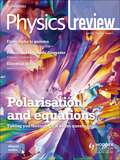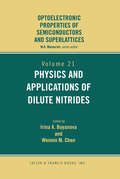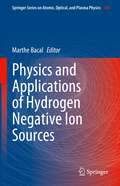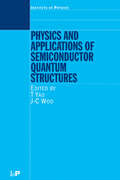- Table View
- List View
Physics Part 2 class 10 - S.C.E.R.T. - Kerala Board
by State Council of Educational Research TrainingPhysics Part 2 textbook for 10th standard from State Council of Educational Research and Training (S.C.E.R.T.) Kerala in English.
Physics Part 2 class 12 - Meghalaya Board
by Meghalaya Board of School EducationThis Physics Text Book (Part – 2) has remained an all-time favorite amongst teachers and students alike. Ideal for the students of class 12, it has been published by the Meghalaya board of school education. It contains exercises at the end of each chapter to help the students evaluate their own knowledge base. Chapters have been divided into subsections and explained in a topic wise manner so that students have a better understanding of the concept. The interactive flow of words will let the students think and practice while they simultaneously learn. Solved examples help the students understand different scientific calculations easily.
Physics Part 2 class 9 - S.C.E.R.T. - Kerala Board
by State Council of Educational Research TrainingPhysics Part 2 text book for 9th standard from State Council of Educational Research and Training (S.C.E.R.T.) Kerala in English.
Physics Part-1 class 11 - NCERT - 23
by National Council of Educational Research and Training.The "Physics Part 1" textbook by NCERT for Class 11 provides an introduction to the vast world of physics, a fundamental branch of science. The initial chapters delve into the essence of physics, discussing its significance and the role it plays in our understanding of the universe. Students are introduced to the core forces of nature, emphasizing the beauty and intricacy of the physical world. As the textbook progresses, readers are familiarized with fundamental concepts, theories, and phenomena, laying the foundation for more advanced studies in the subject. The book is structured to offer a balance of theoretical knowledge and practical understanding, ensuring that students not only learn the principles but also see their applications in real-world scenarios.
Physics Part-1 class 12 - NCERT - 23
by National Council Of Educational Research And TrainingPhysics Textbook Part 1 - Class 12 (NCERT Board) is a comprehensive resource covering fundamental concepts of physics. Topics include electric charges and fields, electrostatic potential and capacitance, current electricity, moving charges and magnetism, magnetism and matter, electromagnetic induction, and alternating current. This textbook aims to develop students' understanding and problem-solving skills through clear explanations, illustrations, and examples. It provides a strong foundation for further studies and future endeavors in physics.
Physics Part-2 class 11 - NCERT - 23
by National Council of Educational Research and TrainingThe NCERT Class 11 Physics, Part 2 textbook provides students with an introduction to advanced physical concepts that form the foundation for deeper study in subsequent years. Emphasizing a conceptual understanding, the book covers topics like thermodynamics, mechanical properties of solids and fluids, kinetic theory, oscillations, and waves. Through clear explanations, diagrams, and real-world applications, students gain insight into the intricate workings of the physical world. The textbook is designed to foster analytical thinking and prepare students for future academic challenges in the field of physics.
Physics Part-2 class 12 - NCERT - 23
by National Council Of Educational Research And TrainingPhysics Textbook Part 2 - Class 12 (NCERT Board) is an advanced resource covering electromagnetic waves, ray optics, wave optics, dual nature of radiation and matter, atoms, and nuclei. Building upon Part 1, this textbook explores these topics in detail. Students learn about wave-particle duality, photoelectric effect, Bohr's model of the atom, and nuclear physics. They also study optical instruments, interference, diffraction, and polarization of light. This textbook aims to deepen students' understanding and analytical skills through clear explanations and illustrations. It provides a comprehensive preparation for higher-level studies and equips students with a solid foundation in advanced physics principles.
Physics Principles and Problems: Laboratory Manual 99/02 Edition
by Glencoe Mcgraw-HillThe Laboratory Manual contains 53 experiments for the beginning student of physics. The experiments illustrate the concepts found in this introductory course. Both qualitative and quantitative experiments are included, requiring manipulation of apparatus, observation, and collection of data. The experiments are designed to help you utilize the processes of science to interpret data and draw conclusions.
Physics Problems for Aspiring Physical Scientists and Engineers: With Hints and Full Solutions
by Ken RileyAn essential part of studying to become a physical scientist or engineer is learning how to solve problems. This book contains over 200 appropriate physics problems with hints and full solutions. The author demonstrates how to break down a problem into its essential components, and how to chart a course through them to a solution. With problem-solving skills being essential for any physical scientist or engineer, this book will be invaluable to potential and current undergraduates seeking a career in these fields. The book is divided into three parts: questions, hints and solutions. The questions section is subdivided into 15 chapters, each centred on a different area of physics, from elementary particles, through classical physics, to cosmology. The second section provides brief hints, whilst the third sets out full and explicit solutions to each problem. Most begin with thoughts that students might have after reading a problem, allowing the reader to understand which questions they should be asking themselves when faced with unfamiliar situations.
Physics Review Magazine Volume 28, 2018/19 Issue 1
by Philip Allan MagazinesThis A-level physics magazine provides up-to-date articles specially written for students to help them gain their highest grade. Exam topics are clearly signposted in articles and there are specific features on maths skills and on approaching exam questions. Physics Review aims to help students with depth of knowledge, revision and avoiding common mistakes in the exam.ContentsProton therapy The swinging ponytail Who were they? Robert R. Wilson, 1914-2000 Exam talkback: Analysing the complexities of waves Mathskit: Angles, units and approximations At a glance: Particle tracks Supernova cosmology Crossword: Clues Physics online: Electricity supply Crossword: Solution and notes Working with physics: Helicopter pilot Tycho's supernova
Physics Review Magazine Volume 28, 2018/19 Issue 2
by Philip Allan MagazinesContentsBouncing bombs: the physics behind the Dambusters raidSkillset: OscillationsMathskit: Simple harmonic motionWho were they? Hedy LamarrCrossword: CluesAt a glance: GPSExam talkback: Radioactive decay and nuclear radiationThe Nobel prize in 1918: quantum physicsPhysics online: The new Elizabethan ageLuis Alvarez: a versatile physicistCrossword: Curves, Chaucer and computing: solution and notesPhysics and war
Physics Review Magazine Volume 28, 2018/19 Issue 3
by Philip Allan MagazinesCONTENTSWhere is the North Pole?Crossword: CluesWill electric cars break the National Grid?Mathskit: Forces, vectors and anglesWho were they? Arthur Eddington, 1882-1944At a glance: Solar eclipseExam talkback: Electric and gravitational fieldsSkillset: Magnetic forces on a current-carrying wirePhysics online: The periodic tableHow loud is that?Crossword: Humidity, eclipses and early scientists: solution and notesMicromotors
Physics Review Magazine Volume 28, 2018/19 Issue 4
by Philip Allan MagazinesViking navigationIsotopes of hydrogenPhysics online: The race to the Moon: 50 years onSkillset: Measuring the Planck constantWho are they? Donna StricklandAt a glance: Polarised lightExam talkback: Polarising filtersCrossword: CluesRadiation: not so simpleMathskit: Forces and free-body diagramsCrossword: Light and heat: solution and notesIndex to Volume 28Cherenkov radiation
Physics Review Magazine Volume 29, 2019/20 Issue 1
by Hodder Education MagazinesElectric vehicles: how do they work?Skillset: Investigating the internal resistance of a cellBuilding the pyramidsPhysics online: Medical imagingAt a glance: Mapping Earth's gravityBrownian motion revisitedMathskit: Areas, volumes and unitsCrossword: CluesExam talkback: Electromagnetic induction and energy transferWho were they? Glenn T. Seaborg (1912-99)Crossword: Telescopes and elements: solution and notesMetallic glasses: properties and applicationsMaking elements
Physics Review Magazine Volume 29, 2019/20 Issue 2
by Hodder Education MagazinesSustainable buildingWhat use are theories?Rutherford's nuclear atom revisitedWho were they? Dmitri Mendeleev, 1834-1907Crossword: CluesPhysics online: RadioactivityAt a glance: Air resistanceFrisbee physics: Peter MainMathskit: Calculating areas and volumesExam talkback: Forces on charged particlesThe Nobel prize in 1919: the Stark effectCrossword: Stability, sliding and stars: solution and notesLeonardo da Vinci
Physics Teacher Education: More About What Matters (Challenges in Physics Education)
by Joan Borg Marks Pauline GaleaThis book focuses on some important aspects of Physics Education: the role of metaphors in Physics teaching and learning, the connections between Physics and Mathematics, the interaction of young children with Physics at the primary level, and recent developments in teacher education in the USA. Contributors present their research related to: • Preparing teachers for TPACK (technological, pedagogical, and content knowledge) and laboratory work. • Developing and evaluating teacher PCK (pedagogical content knowledge) in Quantum Mechanics. • In-service Physics teacher education for early childhood and primary levels. • Pre-service Physics teacher education at all levels. • In-service Physics teacher professional learning for second and higher-level education. Chapters in this book inevitably look into how Physics teacher education is organized in different countries. Suggestions are offered for possible ways of supporting Physics teachers’ learning. An emphasis is made on the much-needed measurements of the effectiveness of different teaching strategies that improve teaching for learning.All this should help professionals, researchers, and pre-service, as well as in-service teachers to get acquainted with the most recent research contributions in the field.
Physics Teacher Education: What Matters? (Challenges in Physics Education)
by David Sands Joan Borg Marks Pauline Galea Suzanne GattThis book presents the most up-to-date research contributions focusing on progress in the field of physics education. It provides researches and results that are based on the most relevant matters in physics teacher education and how these matters can be improved for the satisfaction of both teachers and learners. The work is the by-product of the collaboration between GIREP (the International Research Group on Physics Teaching) and the University of Malta. The contributing authors present close examinations of the following topics: ICT and multimedia in teacher education; experiments and laboratory work in teacher education; the role of quantum mechanics in teaching and learning physics; formal, non-formal and informal aspects of physics education at the primary level; strategies for pre-service physics teacher education at all levels; and in-service teacher professional learning strategies. The editors hope that many different stakeholders within scientific academia will find something of value in this compilation of the current most advanced ideas in physics education.
Physics Trends (Trends in Science)
by Chris CooperToday's fast-moving world of science will have far-reaching effects on all of our lives. Trends inScience is a series of of essential readings for anyone who wants to know more about how his or her future will be affected; as well, the series provides accessible and stimulating material for high school and college students, for researchers and librarians.All titles in the series provide: an introductory overview of the field in the last 100 years, reviewing the past but also predicting the new developments of the future; a detailed chronology of the most important milestones; an index of key terms and concepts; biographies of the most important scientists in each field and their role in shaping their particular branch of science; a listing of important Websites, a directory of organizations, and suggestions for further reading.
Physics Volume-2 class 12 - Tamil Nadu Board
by State Council of Educational Research and TrainingThe textbook for class 12 Physics Vol-2 (English Medium) comprehensively covers advanced concepts in physics tailored for higher secondary students. It delves into crucial topics such as electromagnetism, optics, modern physics, and semiconductor devices, providing a strong foundation for students preparing for board exams and competitive entrance tests. Each chapter presents theoretical explanations, mathematical derivations, and real-world applications to enhance conceptual understanding. The book also includes numerous solved examples, practice exercises, and illustrations to facilitate learning and problem-solving skills. Designed to align with the prescribed curriculum, the textbook ensures a structured and systematic approach to physics, fostering analytical thinking and scientific reasoning among students.
Physics and Applications of Dilute Nitrides
by Irina A. Buyanova Weimin M. ChenSince their development in the 1990s, it has been discovered that diluted nitrides have intriguing properties that are not only distinct from those of conventional semiconductor materials, but also are conducive to various applications in optoelectronics and photonics. The book examines these applications and presents a broad and in-depth look at t
Physics and Applications of Hydrogen Negative Ion Sources (Springer Series on Atomic, Optical, and Plasma Physics #124)
by Marthe BacalThis book gives a comprehensive overview of hydrogen negative ion sources and their applications to particle acceleration and nuclear fusion. The book begins with fundamental aspects of negative ion production by volume and surface processes in hydrogen and its isotopes. It covers key topics, such as the need for separation of negative ion production and extraction regions, the need for lowering the work function of the plasma electrode by using caesium vapor or special materials for caesium-free sources, and the ion extractor structure required for hydrogen negative ion sources. Chapters covering various specific ion sources and applications are written by scientists who participated in their development and include sources for accelerators and for neutral beam injection into controlled nuclear fusion reactors.
Physics and Applications of Negative Refractive Index Materials
by S. Anantha Ramakrishna Tomasz M. GrzegorczykEver since the first experimental demonstration was reported in 2000, the interest in metamaterials and left-handed media that exhibit a negative refractive index has increased exponentially. Surveying this explosive growth, Physics and Applications of Negative Refractive Index Materials covers the fundamental physical principles and emerging engin
Physics and Applications of Semiconductor Quantum Structures
by Takafumi Yao Jong-Chun WooWritten by international experts, Physics and Applications of Semiconductor Quantum Structures covers the most important recent advances in the field. Beginning with a review of the evolution of semiconductor superlattices and quantum nanostructures, the book explores fabrication and characterization techniques, transport, optical, and spin-depende
Physics and Applications of Terahertz Radiation
by Matteo Perenzoni Douglas J. PaulThis book covers the latest advances in the techniques employed to manage the THz radiation and its potential uses. It has been subdivided in three sections: THz Detectors, THz Sources, Systems and Applications. These three sections will allow the reader to be introduced in a logical way to the physics problems of sensing and generation of the terahertz radiation, the implementation of these devices into systems including other components and finally the exploitation of the equipment for real applications in some different field. All of the sections and chapters can be individually addressed in order to deepen the understanding of a single topic without the need to read the whole book. The THz Detectors section will address the latest developments in detection devices based on three different physical principles: photodetection, thermal power detection, rectification. The THz Sources section will describe three completely different generation methods, operating in three separate scales: quantum cascade lasers, free electron lasers and non-linear optical generation. The Systems and Applications section will take care of introducing many of the aspects needed to move from a device to an equipment perspective: control of terahertz radiation, its use in imaging or in spectroscopy, potential uses in security, and will address also safety issues. The text book is at a level appropriate to graduate level courses up to researchers in the field who require a reference book covering all aspects of terahertz technology.
Physics and Astrophysics: Glimpses of the Progress
by Subal KarPhysics and Astrophysics—Glimpses of the Progress provides a comprehensive account of physics and astrophysics from the time of Aristotle to the modern era of Stephen Hawking and beyond. It takes the readers of all ages through a pleasant journey touching on the major discoveries and inventions that have taken place in both the macro-world, including that in the cosmos, and the micro-world of atomic and subatomic particles related to physics and astrophysics. Use of historical perspective and anecdote makes the storytelling on the progress of physics and astrophysics both interesting and absorbing. While peering through different developments in these fields, the book never compromises with the sanctity of the scientific content, including the depth and beauty of the physical concept of the topics concerned and the philosophical viewpoints they represent. Where appropriate, the book also delves into value judgments of life that affect our civilization. Features The intricate concepts of physics and astrophysics are explained in simple terms and in easy-to-understand language. Physics and astrophysics are discussed in a connected and correlated way in a single volume of comprehensive size but in totality, which to date is the unique feature of this book. Starting with Aristotle’s Physics and going through the work of Newton, Einstein, Schrödinger, Hubble, Hewish, Hawking, and others, including the present research on dark energy, dark matter, and the fifth force of nature, the reader will be kept absorbed and spellbound. In addition to the fundamental principles of Newtonian mechanics, Einstein’s relativity, quantum mechanics, string theory, loop quantum gravity, and so on, the cutting-edge technologies of recent times, such as the Large Hadron Collider, Laser Interferometer Gravitational-wave Observatory, and Event Horizon Telescope, are also explored. The book is aimed primarily at undergraduate and graduate students, researchers, and professionals studying physics and astrophysics. General readers will also find the book useful to quench their thirst for knowledge about the developments in physics and astrophysics.





















